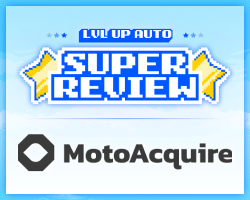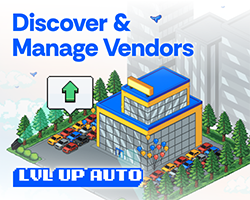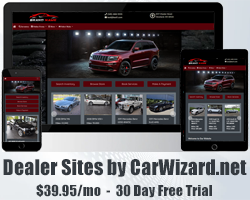Hopefully you read through the Introduction to this CRM series, but if you didn’t that’s okay because you’ve landed on the most important part of the series: CRM Process. In order to sell more cars, get more service appointments, and just get more customers using your dealership in general it all boils down to good follow-up. This is where the needle is  moved and this is where you change the gap with your competitors because this is where CRM makes the difference. Don’t let anyone tell you different.
moved and this is where you change the gap with your competitors because this is where CRM makes the difference. Don’t let anyone tell you different.
Process management is not an easy silver bullet (do those actually exist?); it does require quite a bit of work. You can’t simply write a check for this one, and no vendor, consultant, or trainer can maintain the consistency you need in this area. If you want to own your market and make your customers happy then this is where the right-fitting CRM can help you get that done.
It is all about the basic user (anyone speaking to customers as their primary job function). I know your basic users aren’t the ones making the decisions on which CRM you should buy, and they probably shouldn’t. I can imagine quite a bit of chaos with too many cooks in the kitchen. However, you are the decision maker and you should be thinking about them before thinking about how you will use the system and how much it costs. CRM is priceless by the way.
On a side note, if you ever have any CRM questions, the DealerRefresh community can help in the CRM and ILM forum 24/7.
What to look for in the demo:
There are only a few screens needed for a basic user:
- Customer Entry Screen
- Customer Details Screen
- Forms
- To-Do Screen
Start with these. You need to get a very good idea of what your basic user will be doing multiple times a day everyday. If it is tedious, ugly to look at (subjective I know), and unintuitive then your people will hate it. I’ve seen some CRM rebellions by basic users and they do nothing but waste everyone’s money.
Customer Entry Screen:
- How many screens does it take to enter a customer? Are they all pop-ups or new browser windows?
- What are the required fields and can you control what those are (can you make adding an email address a required field?)?
- How easy is it to attach a vehicle of interest?
- How easy is it to add a trade-in?
- After adding basic five-liner stuff is it simple to get into the area where you add financial information for a credit application?
- Does the screen promote the addition of an ad source? If so, does it have things like Walk-in, Drive-by, Internet Lead, Phone-up, or Manual Entry? If those are present ask why because those things are unnecessary. Those are channels; not ad sources.
Spend a lot of time here.
When it comes to the license scanner, is it a windows-based system that has to be reinstalled every time the scanner is disconnected? Do you really need a license scanner or are you simply looking for a way to upload a picture of the customer for a future reminder of who he or she is? How important is a license scanner to you?….really think hard about that question because most of them are crap.
Customer Details Screen:
- How easy is it to view the history of communications?
- Can emails and phone calls be completed from this screen?
- Can forms be printed from this screen?
- How easy is it to edit the fields in this screen?
Forms:
- Is it just a print-out of data from the customer details screen?
- Can you actually edit the form before it is printed?
- Are the forms large PDF’s that take forever to load?
- Can you add customized forms?
To-Do Screen:
- Can basic users override the process by delaying calls or changing process triggers?
- Does sending an email or making a phone call require doing so from a different screen or pop-up?
- Can you prioritize which calls are most important to make? This helps to tone-back sales agents cherry-picking their calls.
- Is enough information about the customer shown for an agent to only use this screen?
The To-Do screen is where you want your people to spend most of their time in the CRM. This is an extremely important screen. Spend some time with this one and imagine what it is like to interact with it everyday – could you use this screen every time you step into the office? It may look cool today, but will this screen continue to be affective a year from now?
The To-Do screen should also play to the numbers game. What do I mean by that? Sales is a numbers game right? The goal of any salesperson should be to speak to as many customers as possible. Talent is simply a measure of how many customers one needs to work with to hit a number of sales. If this screen promotes time spent digging through the customer history or doing anything other than just calling it might not be the best screen for getting the job done; you be the judge of that.
Here’s an example of what I’ve seen:
I used to watch the time a sales agent or BDC agent interacted with each to-do item. I’d stand somewhere where they didn’t know I was watching and I would time them. I found that most agents pulled-up a to-do item and immediately dove into the customer history. They’d mentally formulate where the call was going to go and maybe call some of their coworkers who had worked with that customer before – this is time wasting at its finest. I found that, on average, it was taking my people roughly 10 minutes to get their head straight before picking up the phone (ridiculous – I know). I had to train people to just dial and go. What they found was the customer would tell them what was important or they could rely on our phone guide/scripts to help get them through the call. 3-5 minutes is optimal for completing a to-do which includes the time spent on the phone with the customer. If you need phone training help, I recommend looking at Phone-Up Ninjas or Traver…..there are many others too.
For a Manager:
You want to be sure your managers have easy access to everything that is transpiring throughout the day. Typically they do this through a dashboard. What should a manager dashboard have?
- Ability to see all agents completing their follow-up
- All traffic that came into the dealership (floor, phone, Internet, and maybe even Service depending on your own needs)
- Month to Date sales
- Appointments generated for the day with the appointments that are scheduled to show up
There are many other things that can be on a manager dashboard, but these are bare minimums. The dashboard is important and should be able to help managers hold their people accountable for a day’s CRM work at a glance. You should spend a lot of time looking at this screen as it is where sales managers should live.
If your managers are not confirming appointments, then I suggest you get them started on this practice immediately. A proper manager confirmation call almost doubles the likelihood a customer will actually show-up for that appointment, and it helps to make sure your agents aren’t gaming the system.
There are a number of ways to handle this call, but here’s a very basic example:
Hello [Mr. Customer], I am [John Doe] from [ABC Motors]. I am [Sally Smith’s] manager and I just wanted to say thank you for taking time out of your day to work with [Sally this Thursday at 11:48]. I am looking forward to meeting you. I will be the one helping [Sally] make sure your experience is fantastic. I have set aside some time to sit down with you, so please let [Sally] know if you’re going to be early or late. Do you have her phone number?…..
If the CRM has a way to track confirmation calls, that is a big bonus!
You should also look at how easy it is for managers to dive into reporting and generate lists of customers quickly. I’ll talk more about reporting under the Decision-Making portion of this series, but Searching capabilities are ways to help managers task their staff with more stuff to do if they ever catch someone standing on the point waiting for the Up Bus. Be sure you thoroughly test the search capabilities – your entire staff will be using it daily.
A manager should also have To-Do’s, so be sure that To-Do screen is just as good for them as it is for your basic users.
Building the processes:
Hopefully your CRM company will give you a default set of processes based on best practices they’ve seen in their own system. Anytime someone gives you a list of processes, grab that opportunity, even if you feel like your own are dialed in because there may be a step or two you will want to use in the future.
The first thing you want to consider when looking at the process building section of the CRM is whether it is easily understandable. If it isn’t easily understandable, or you aren’t assigning someone to own the CRM, you’re going to hate tweaking those processes. Tweaking those processes is a key element to CRM utilization. You should always be looking for ways to make the processes better, and should seriously consider hiring an expert in this area that is part of your full-time staff. I like to think of this person as the CRM Architect and that person should be able to translate technology into real world usage. I have not met many people who can do that, so treasure that person if you ever find him/her.
Aside from looking for simple understanding of how to set and tweak processes you should first get a list of all the triggers in the CRM. These may be referred to as “if” items: If Customer Entered into system. Look through the list and see if it covers everything you want it to and maybe even gives you some new ideas.
After digesting the triggers look at the actions. Actions are the “then” items: Send automatic email. Think of the combination of the triggers and actions: If Customer Entered into system – then – send automatic email. Just as you digested the triggers, do the same with the actions. Do they cover everything you want them to and do these give you some new ideas?
Beyond triggers and actions you have the basic when’s and who performs the action stuff. Make sure actions can happen at least by the minute. If you have to wait for an action to happen at midnight, then that should be unacceptable to you. Also make sure you have the ability to assign actions to different people. A sales agent isn’t the only person working in the dealership, so you should be able to include other people in your follow-up process.
Can notifications be built into the process? It is unrealistic to think the dealership staff is going to sit in the CRM all day. There are action items that will come up from time to time that you’re going to want someone to act on quickly, so they’re going to need a notification by email or text message to let them know to get back to the CRM.
There are more sophisticated CRM systems that add even more functionality here such as adding phone scripts, email templates, and the reasons why a customer is showing on a To-Do screen. I am a big advocate of these things, but it is possible to get the job done without them.
Conclusion:
Sales is a numbers game. You speak to enough customers you’ll sell enough cars. Talent is simply a ratio changer. I have not met a sales professional who has ever argued this. CRM fuels the numbers game. Sure, you can throw an incredible amount of money at your marketing, but you’ll close more with proper follow-up through good process. This is why the items outlined in this part of this CRM series is the most important.
Things like social media look-ups, inventory integration, and DMS integrations don’t fuel the numbers game. They’re “nice to haves.” I will cover some of these items in the reporting and decision-making parts of the series.
If you want to move the needle in your dealership, through CRM, concentrate on playing the numbers game better. It is priority number 1.
How to buy a dealership CRM series:
Part 1: Introduction
Part 2: Process (this article)
Part 3: Marketing
Part 4: Decision-Making
Part 5: Conclusion









